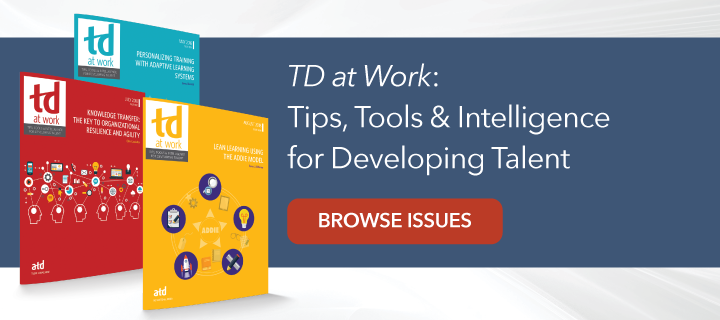Healthcare is a high-stress field—after all, a person’s life and death may be on the line. What’s more, practitioners face rising pressures to produce better outcomes at lower costs.
“Healthcare team members are burdened daily when asked to deliver high-quality care at a lower cost,” write Christina Barss and Angela J. Patchell in the August 2019 bonus issue of TD at Work, “Implement Interprofessional Education in Healthcare.”
Amid this backdrop, workers are reporting worsening rates of burnout, which is often characterized by emotional exhaustion and a low sense of personal engagement and fulfillment. This makes it harder to connect with patients and deliver quality care and satisfaction.
What’s more, the roles and skills needed to provide quality care is diverse—ranging from medical, to administrative, to technical, to facilities management. Unfortunately, “all too often, friction and tension exist at those junctions,” note Barss and Patchell.
Enter IPE (interprofessional education). IPE is a collaborative learning and training method that brings together two or more professions and provides a safe, practical framework where all employees share a common purpose.
According to Barss and Patchell, “Bringing healthcare staff together to learn with, and from, each other helps break down silos and generates greater understanding of others’ perspectives and what other co-workers being to the table.”
In other words, by conducting learning experiences across professions, learners not only gain the necessary skills and knowledge to do their jobs, they develop the bonds and connections needed to create a table, supportive, and safe work environment. The payoff is obvious: enhanced quality of patient care, reduced errors, and a boost to employee morale.
So, how do you integrate IPE into training?
When designing interprofessional education healthcare, the authors say to follow these basic guidelines:
- Stay focused on the patient.
- Connect learning objectives to safety and quality interventions.
- Identify real-world tasks that different disciplines and professions share and create uses.
- Use simulations when and where appropriate to immerse learners in psychologically safe manner.
- Be cognizant that you are building a bridge to effective teamwork.
- Blend task and trust-building into the learning experience.
Check out “Implement Interprofessional Education in Healthcare” to see how organizations like Cleveland Clinic and Christiana Care Health System are integrating the IPE model into its workforce development. You will learn some practical tips for using this approach to break down silos and lift up learning—whatever the industry.





